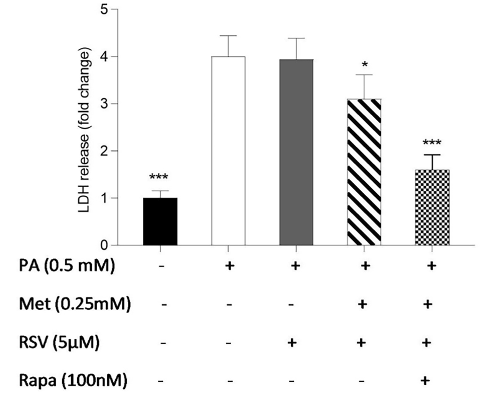Key Points:
- Combining the longevity-associated compounds resveratrol and metformin (RSV-Met) synergistically reduces liver cell fat content.
- RSV-Met synergistically promotes autophagy — our cellular waste disposal system that declines with aging.
- Liver cell death is synergistically reduced when RSV-Met is combined with the most potent longevity compound — rapamycin.
Fat build-up in our liver ensues just after a few days of heavy drinking. Nevertheless, fat deposits can accumulate in our liver without consuming one drop of alcohol, a condition called nonalcoholic fatty liver disease (NAFLD). The causes of NAFLD are largely unknown, thus far leaving scientists stumped on how to establish treatments. However, with combination therapies, things may be on track.
As published in Naunyn-Schmiedeberg’s Archives of Pharmacology, researchers from Shahid Beheshti University in Iran have found that RSV-Met synergistically combats NAFLD. Afshari and colleagues show that RSV-Met reduces liver cell fat content and promotes autophagy. Furthermore, adding rapamycin to the mix reduces liver cell death. These findings suggest that RSV and Met can be combined at low doses to treat liver disease with minimal side effects.
Metformin, Resveratrol, and Rapamycin Work Together to Mitigate Liver Disease
Especially in older individuals, NAFLD can progress to nonalcoholic steatohepatitis (NASH), a disease characterized by inflammation and tissue scarring that can lead to liver failure. To induce NASH, Afshari and colleagues exposed human liver cells to palmitic acid (PA), a saturated fat with high abundance in palm oil. This caused a pronounced increase in liver cell fat content.
The researchers then treated the liver cells with low doses of Met or RSV to test their effects individually. While Met had no significant effect, RSV was shown to reduce liver cell fat content. Moreover, RSV-Met reduced fat content further than RSV alone. These findings suggest that RSV and Met have a synergistic effect in reducing liver cell fat content.

Our cells have a built-in waste disposal system called autophagy. The autophagy process has been reported to decline with age, allowing unwanted material like defective proteins to disrupt the harmonious orchestration of our cellular machinery. Defective autophagy is associated with age-related conditions like neurodegeneration, liver disease, and heart disease.
Afshari and colleagues assessed autophagy by measuring various genes and proteins, including a gene called Beclin-1. Met or RSV alone did not affect Beclin-1. However, RSV-Met nearly restored Beclin-1 to levels similar to that measured from healthy liver cells. These findings suggest that RSV-Met reduces liver cell content by promoting autophagy.

An enzyme called sirtuin 1 (SIRT1) has been linked to longevity as it extends average lifespan and alleviates diseases in model organisms. Afshari and colleagues blocked SIRT1 to find that the autophagy-promoting effects of RSV-Met went away. Furthermore, pharmacologically blocking autophagy itself prevented RSV-Met from reducing fat content. Together, these results suggest that RSV-Met reduces fat content by activating autophagy through SIRT1.
To further explore the effects of RSV-Met on NASH, the researchers measured liver cell death levels. They found that Met or RSV alone did not reduce liver cell death. However, when combined, they suppressed cell death. Furthermore, when combined with rapamycin, RSV-Met doubled the reduction in cell death. Rapamycin is the most reliable and robust compound to extend the lifespan of mice and known to promote autophagy. Thus, rapamycin may enhance cell survival by activating autophagy along with RSV-Met.

Overall, the findings of Afshari and colleagues suggest that combining Met, RSV, and rapamycin can synergistically promote autophagy to mitigate NASH. While RSV and Met seem to promote autophagy through SIRT1, rapamycin is known to activate autophagy by inhibiting a protein complex called mTOR. Thus, these two autophagy-promoting pathways appear to complement each other.
Combining Longevity-Associated Compounds to Combat Aging
Autophagy is a hallmark of aging, a biological process that underlies many age-related diseases. Aging hallmarks occur in almost every cell, affecting nearly every organ, albeit at different rates and levels. Likewise, SIRT1 and mTOR are present in all cells and can be targeted by compounds like RSV, Met, and rapamycin. Therefore, it is possible that the combination of RSV, Met, and rapamycin can combat diseases other than NASH.
It is also possible that other combinations of longevity-associated compounds can combat multiple diseases. For example, one study showed that the combination of rapamycin, acarbose, and phenylbutyrate improved learning and enhanced strength in aged mice. Therefore, while human studies are needed, combination therapies can potentially treat multiple age-related conditions like liver disease, cognitive decline, and muscle decline.